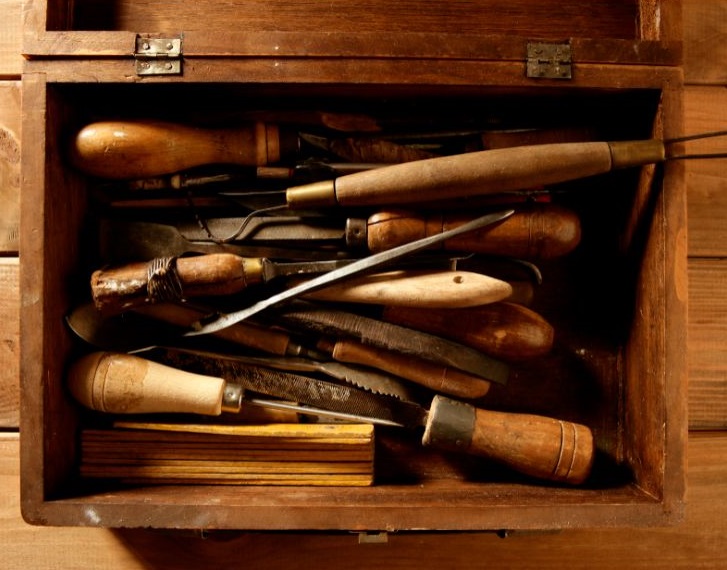The change in carpenters chisels
The evolution of carpenters’ chisels in the UK is a testament to the enduring ingenuity, craftsmanship, and innovation of woodworking tools throughout history. From their humble origins as hand-forged steel implements to their modern incarnations as precision-engineered cutting instruments, carpenters’ chisels have undergone significant changes in design, materials, and functionality, reflecting shifts in woodworking techniques, industry standards, and user preferences among carpenters and woodworkers across the country.
Historically, carpenters’ chisels were simple hand tools consisting of a steel blade and a wooden handle, typically made from hardwoods such as beech or ash. These early chisels were hand-forged by skilled blacksmiths and ground to a sharp edge, allowing carpenters to carve, shape, and trim wood with precision and control. The wooden handles were often elegantly turned and finished to provide a comfortable grip and maximum leverage during use.
As industrialization and mass production transformed the woodworking industry in the 19th century, new materials and manufacturing techniques began to revolutionize the design and functionality of carpenters’ chisels. One of the most significant changes was the introduction of metal-framed chisels, which replaced traditional wooden handles with cast iron or steel frames. This innovation offered several advantages over wooden-handled chisels, including increased durability, stability, and precision.
Metal-framed chisels featured adjustable mechanisms for setting the depth of the blade and controlling the angle of the cut, allowing carpenters to achieve finer and more precise results with less effort. These advancements in design and functionality made metal-framed chisels highly versatile tools that could be used for a wide range of woodworking tasks, from chopping mortises and paring joints to carving intricate details and shaping wood surfaces.

Another significant change in the design of carpenters’ chisels was the introduction of specialized chisels for specific tasks and applications. While traditional bench chisels remained popular for general-purpose woodworking, new designs emerged to address the needs of carpenters working with different materials and construction techniques. For example, mortise chisels featured thicker blades and stronger bevels for chopping out mortises, while carving chisels were designed with narrower blades and finer edges for shaping and detailing wood.
In addition to changes in materials and design, the way carpenters used chisels also evolved over time, reflecting shifts in woodworking techniques, industry standards, and user preferences. As power tools and machinery became increasingly common in woodworking shops and factories, hand chisels were often relegated to secondary roles or used in conjunction with automated equipment for finer detailing and finishing work.
However, the advent of hand tool woodworking and a renewed interest in traditional craftsmanship in recent decades has led to a resurgence of interest in hand chisels among carpenters and woodworkers in the UK. This renewed appreciation for hand chisels has sparked a reevaluation of their role in modern woodworking practice and a rediscovery of their versatility, precision, and tactile feedback.
In response to this renewed interest in hand tool woodworking, many tool manufacturers have introduced new lines of hand chisels that combine the best elements of traditional design with modern materials and engineering techniques. These contemporary hand chisels feature precision-machined blades made from high-carbon steel or alloy steel, finely ground edges for sharp and accurate cutting, and ergonomic handles designed for comfort and control.
Furthermore, advancements in machining technology and computer-aided design have made it possible to produce hand chisels with tighter tolerances and finer bevels than ever before, ensuring smooth and consistent performance in a wide range of woodworking tasks. Whether chopping mortises, paring joints, or carving intricate details, modern hand chisels offer carpenters unparalleled precision and versatility in achieving their desired results.
The change in carpenters’ chisels in the UK is a testament to the enduring relevance and adaptability of these timeless tools in the woodworking industry. From their humble beginnings as hand-forged steel implements to their modern incarnations as precision-engineered cutting instruments, carpenters’ chisels have evolved over the centuries to meet the needs of carpenters and woodworkers in an ever-changing world. Whether chopping mortises, paring joints, or carving intricate details, hand chisels continue to play a vital role in the craft of woodworking, embodying the spirit of tradition, craftsmanship, and innovation in the UK woodworking tradition.